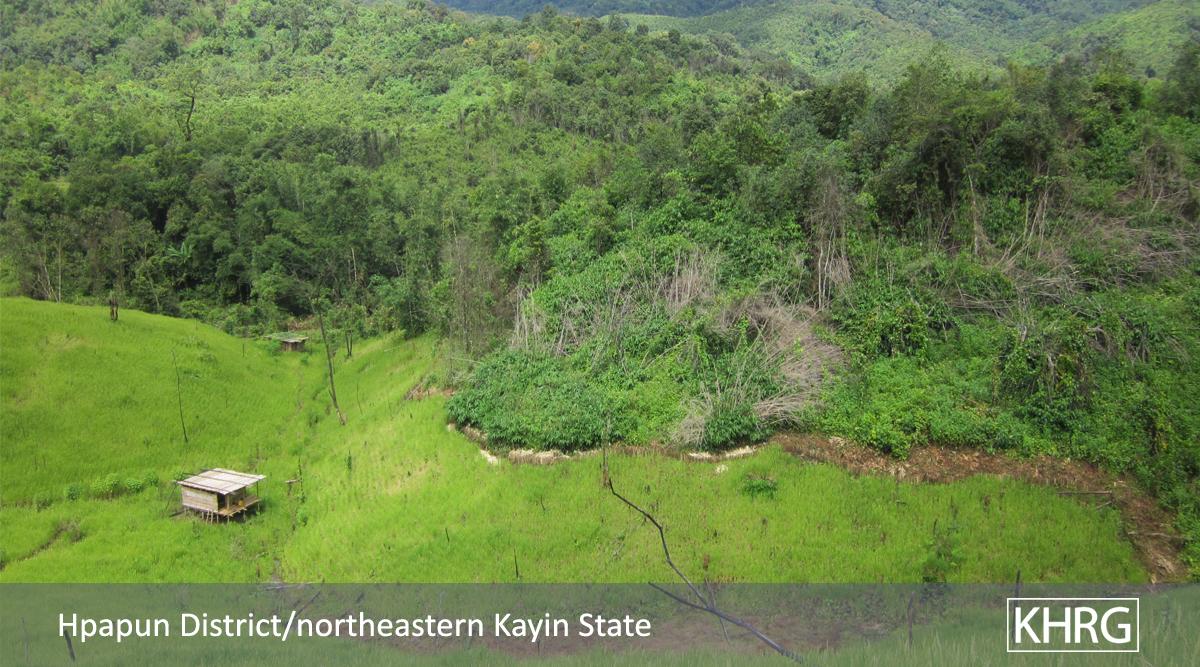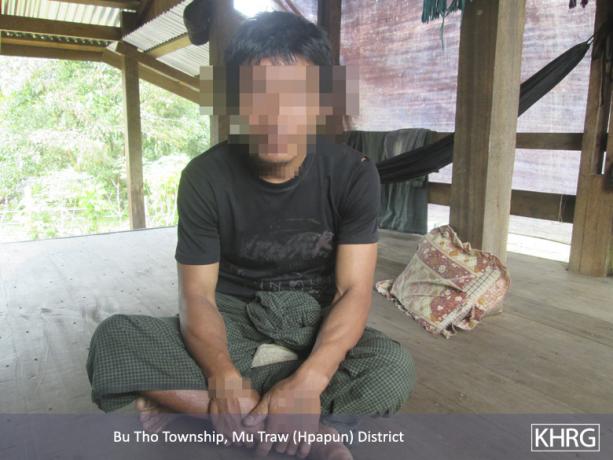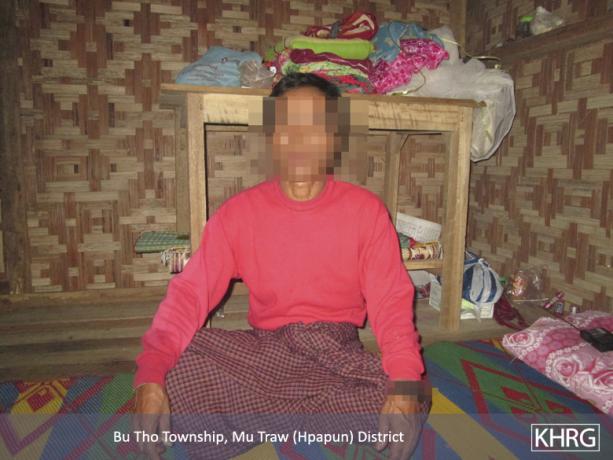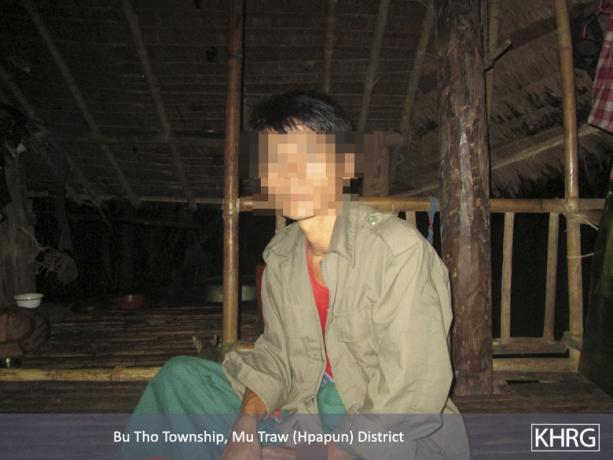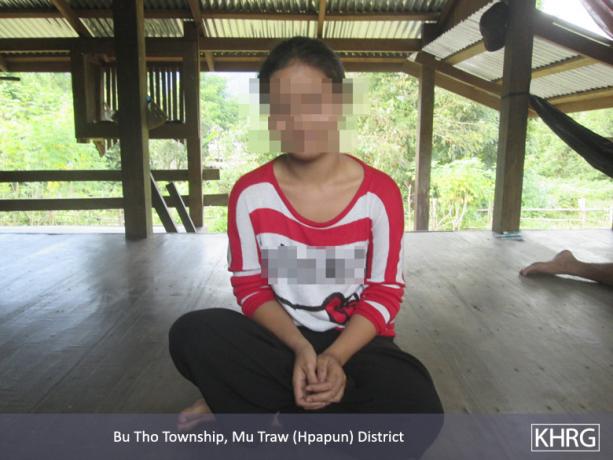This News Bulletin describes villagers' displacement following rumours of Karen National Liberation Army (KNLA) forced recruitment, and a small clash between the KNLA and Tatmadaw soldiers, as well as arbitrary detainment and violent abuse in Bu Tho Township, Hpapun District, in September 2015.
- Between September 27th and 28th 2015, villagers reported to KHRG that four villagers from A--- village and 10 villagers from B--- village, Kyaw Pah village tract, were detained by KNLA soldiers because villagers failed to arrange ten male adults to serve as KNLA soldiers. However, the KNLA stated they merely wished to come to an agreement with the villagers regarding their recruitment targets for replacing soldiers whose term of service had ended. The KNLA later released these 14 villagers, and stated that their invitation to attend a discussion meeting regarding the recruitment was misunderstood by villagers as an attempt at forced recruitment.
- On September 28th 2015, almost all villagers from A--- and B--- villages, Bu Tho Township, Hpapun District, fled to Myaing Gyi Ngu Town, in Hlaingbwe Township, Hpa-an District, to evade what villagers thought were KNLA’s arbitrary arrests and forced recruitment in the area. When the KNLA sent soldiers to reassure villagers and ask them to return, more villagers fled prior to hearing the KNLA's explanation.
- On September 30th 2015, two KNLA soldiers fired warning shots at Tatmadaw soldiers who were patrolling in their territory and as a consequence, the Tatmadaw arrested and violently abused a 62-year-old male villager, while accusing him of not informing them of the KNLA soldiers’ whereabouts. This incident further exacerbated villagers’ displacement, as more villagers fled to Myaing Gyi Ngu Town out of fear of potential fighting in their village.[1]
Karen National Liberation Army (KNLA) detention of villagers in relation to their recruitment targets causes mass-displacement of villagers
Between September 27th and 28th 2015, KNLA soldiers from Company #4 detained a total of 14 people from A--- and B--- villages, Kyaw Pah village tract, Bu Tho Township, Hpapun District, including both village heads and ordinary villagers, after the villagers failed to arrange ten adult males to join the KNLA. This detainment led to widespread fear among villagers and resulted in many villagers[2] fleeing to Myaing Gyi Ngu Town to evade the KNLA arbitrary detainment.
Between October 9th and October 15th 2015, a KHRG community member met and interviewed 15 people, including village heads, village secretaries, villagers who had been detained and then released by the KNLA, as well as villagers who had fled and remain displaced.
Saw C---, a 38-year-old A--- villager who witnessed the detainment, reported to a KHRG community member:
“They came to arrest six fathers in A--- village. One of these men fled the village before they could arrest him; one fled on the way to the KNLA camp; and so only four [A---] villagers were arrested and detained at the KNLA camp. When they [KNLA soldiers] came to arrest villagers, they did not tie them. The people they arrested included a village secretary who they appointed [and] two village heads. All four of them are released now. [When they were detained] they were brought to Meh Mgeh village [where the KNLA was based at the time] and met with KNLA Company #4 Commander Hsa Yoo.”
Saw C--- added that the day after the detainment of villagers, when the villagers remaining in the village were worshipping together, they said amongst themselves, “People arrested our parents and village leaders, and we are on our own now and have to observe the situation. If our parents [leaders] do not come back within one or two days, we will have to look for our new parents [leaders].”
52-year-old B--- villager Saw D---, who was detained by the KNLA soldiers from Company #4, had a slightly different take regarding the detainment:
“It was not like they arrested me [for a crime], but since they are military, they are strict, and they did not allow me to get into my house, so my neighbours who witnessed the incident thought they came to arrest me so they were worried and they talked to each other and said, 'It is not a good situation for us; they would arrest us too.' After I followed the soldiers, when I got back to the village, almost all the villagers were gone.”
Saw D--- added that after he was detained, he was sent to Meh Mgeh village where he met with the KNLA Company #4 Commander Hsa Yoo. He and nine other B--- villagers had to stay in Meh Mgeh village for nine days and wait for the Company #4 Commander to arrive.When he and the other nine villagers finally met Company #4 Commander Hsa Yoo, the Commander told them:
“We directed the lower officers and the village tract leaders about the recruitment. Ten people from each village tract have to serve as soldiers. So, the military went to meet with the parents and village leaders and bring them in here [to make sure they comply with the order].”
Saw C--- also noted the KNLA did not detain the 14 villagers to have them serve as soldiers. Rather, the purpose of the detainments was to discuss and come to an agreement between village heads, parents, and KNLA officers regarding the KNLA’s recruitment targets, and potentially convince parents to sign a document promising to send their sons to serve with the KNLA when they turn 18 years old.
Saw E---, who is the KNU’s F--- village tract [position censored for security], provided additional details of the intentions behind the detainments:
“A township-level KNLA commander directed the village tract leaders to arrange ten unmarried male adults from each village tract to join and serve the KNLA. Then, the village tract leaders and village heads decided to gather three unmarried male adults from each big village and one to two unmarried male adults from each small village, but villagers did not agree with the proposal. Therefore, the [KNLA] company that operates in the area demanded that village heads [provide them] the list of names of all unmarried male adults in each village and the village heads gave the list to them. Afterward, they ordered the parents [of all eligible adult males] to meet with them; the reason was because some of their sons have migrated to Thailand for work, while some are still studying [so they are presently unable to serve for the KNLA]. They [the local KNLA soldiers] acted beyond [what was stated in] the order [from their superiors] by arresting all parents whose names were on the list. We [local KNU] were not given the order to arrest the parents; only the sons.”
The villagers who were detained have been released by the KNLA as of early October 2015, but this did not restore local villagers' sense of safety, and many still chose to flee B--- and A--- villages.
According to Saw C---, villagers fled because of three reasons. First, they saw that when a person who has been called to serve for the KNLA was not in the village, the KNLA soldiers detained one of their family members, so many villagers ran to evade a potential detainment. Other villagers were worried that the Tatmadaw and the Border Guard Force (BGF)[3] might decide to take advantage of the instability created by the KNLA recruitment and conflict with the villagers, and enter into the village to engage in fighting with the KNLA, which would cause villagers to flee with their children with no preparation. Because of this concern, many villagers decided to pre-emptively send their children to Myaing Gyi Ngu Town and follow them there. Finally, some of the villagers fled to Myaing Gyi Ngu Town because they saw other villagers escape and they did not dare to stay behind in the village.
On April 14th 2016, a KHRG member met with the KNLA Brigade #5 Brigade Major to obtain the official KNLA explanation for the detainments and subsequent displacement. The Brigade Major explained that the KNLA needs to recruit soldiers in order to replace the soldiers who finished their term of military service, injured soldiers, and deceased soldiers; they are not aiming to increase the number of soldiers. The Brigade Major stated that the KNLA is committed to only recruiting individuals who are 18 years old or older, and intend for recruitment to be done through transparent discussion with villagers and with their agreement. In order to reach such an agreement, the KNLA called a meeting with villagers with the intention of discussing which villagers to recruit and how recruitment should be carried out. The villagers they called to come to the meeting included the villagers whose sons were eligible for military service. After the meeting, these villagers went home, and some of them fled to avoid the recruitment.
The Brigade Major stated that when these villagers fled, other villagers thought that KNLA were doing forced recruitment, so more villagers started to flee. He explained that this was not KNLA's intention, and as the time was important in the farming calendar, the KNLA attempted to clarify the misunderstanding and reassure the villagers. Hence, they asked their soldiers to go to the villages and bring the villagers back. However, when soldiers went to gather villagers in order to bring them back to the KNLA base, this activity was also misinterpreted by the villagers as forced recruitment, and more villagers decided to flee.
On May 18th 2016, a KHRG community member met with the KNLA Brigade #5 Brigadier General and he confirmed that it was a rumour that the KNLA conducted forced recruitment in Kyaw Pah village tract, Bu Tho Township, Hpapun District. He also confirmed that it was true that villagers fled to Myaing Gyi Ngu Town because of the rumour and misunderstanding regarding KNLA forced recruitment. He added that he directed his subordinate commanders to go and meet with villagers in Kyaw Pah village tract, and after they complied with his order and met the villagers, some of the villagers returned to their home village, beginning in January 2016, while some still remain in Myaing Gyi Ngu Town.
Small clash between Tatmadaw and KNLA exacerbates displacement of villagers
On September 30th 2015, around 40 Tatmadaw soldiers from Light Infantry Division (LID)[4] #22 were seen patrolling in KNLA-controlled B--- village. KNLA soldiers who were also patrolling there fired two or three warning shots in their direction.
Following the shots by KNLA soldiers, the Tatmadaw soldiers arrested a 62-year-old B--- villager named Saw G--- while he was grazing his cows beside a paddy farm. They accused him of not informing them of the whereabouts of the KNLA soldiers, and two Tatmadaw officers hit him in the chest and on the ear two or three times each with their gun muzzles.[5]
According to Saw G---, the Tatmadaw soldiers have never been to B--- village prior to this incident, as they are not allowed by the KNLA to patrol in that area based on the 2012 ceasefire agreement.[6] He also noted that following his arrest and violent abuse, many villagers who had not fled immediately after the KNLA arbitrary arrests decided to flee to Myaing Gyi Ngu Town, as well, leaving B--- village nearly empty. These villagers fled because they were worried that the Tatmadaw presence in the village may lead to fighting, and they would have to flee along with their children without any preparation. They also feared their children might be injured if fighting did take place. In addition, villagers reported that the Tatmadaw accused them of shooting the warning shots; therefore, villagers were concerned about the consequences they may face.
Saw G--- also reported to a KHRG community member:
“Some villagers came to me and I told them that the Burmese [Tatmadaw] soldiers do not come frequently. Then, they told me Burmese [Tatmadaw] soldiers do not differentiate between the [KNLA] soldiers and villagers. Therefore they asked me, ‘If the Tatmadaw soldiers come another time and shoot at us, will you take responsibility [to guarantee our safety]?’ I told them, 'I cannot [take responsibility], it’s up to you.” He updated that the situation in the village has been stable as of October 14th 2015, with no more arrests or fighting, however many villagers remain displaced.
Schools close following the mass displacement of villagers
A primary school in A--- village and middle school in B--- village were both closed for a week because when villagers fled to Myaing Gyi Ngu Town, they brought their children with them. According to Naw J---, a middle school teacher in B--- village, the school was closed for 5 days and currently there are only two schoolteachers remaining and teaching at the school. They run the school for only half of the morning and are only able to teach their own subjects and not those which were previously taught by the displaced teachers. On the first day, the schools re-opened after the villagers' displacement, there were only seven or eight students who attended the schools, and as of October 2015, there are about 60 to 70 students attending the school in B--- village. Saw C---, a villager from A--- village reported that in his village, there were less than ten students remaining in the village as the rest fled to Myaing Gyi Ngu Town.
Before the displacement, there were around 100 students and 11 teachers in B--- village, and in A--- village, there were also around 100 students and six teachers. Both schools are Burma/Myanmar government school branches, and the Burma/Myanmar government teachers also went to Myaing Gyi Ngu Town when villagers fled there.
Saw C--- added that after the A--- village head was released from the KNLA camp, he went to Myaing Gyi Ngu Town and asked villagers to return to the village and he asked the teachers to go back and teach at the school in the village, but the local Burma/Myanmar authorities did not allow the teachers to return. Therefore, the A--- village head requested that the Myaing Gyi Ngu Town Burma/Myanmar government authorities arrange for the displaced children to study there.They agreed and the children are now studying in Myaing Gyi Ngu Town. Even some children whose parents did not flee A--- village now travel back and forth to attend school in Myaing Gyi Ngu Town.The food and school materials are being provided either by Colonel Chit Thu[7] or the Burma/Myanmar government. If the situation stabilises, the teachers should be able to come back and teach at the school in the village again.
Impact of villager displacement on livestock and livelihoods
The villagers who fled left their paddy fields and livestock behind, and they asked other villagers who remain in the village to help feed their animals.
According to A--- villager Saw C---, two or three villagers from A--- village sold their cows cheaply to help them cover the transportation and living costs while they are in Myaing Gyi Ngu Town. Some villagers said that they would resort to selling their livestock but not their lands. They will come back and work on their land when their situation stabilises.
Uncertain plan for return
A few days after villagers fled, KNLA representatives held a meeting in B--- village. B--- villager Saw H--- who attended the meeting told the KHRG community member:
“A few days ago, they [KNLA representatives] came and held a meeting with us [B--- villagers] and told us, ‘Gather the villagers who fled and tell them to return and harvest their paddy and work for their livelihoods and live in the village like before and not flee. We won’t harm you. We would follow the [recruitment] order [from our superiors] like we did in the past and we would not forcefully [detain] you anymore.’”
Saw H--- also added that the KNLA officer asked to inform the villagers who fled to Myaing Gyi Ngu Town that he promises to watch over and protect their properties from dispossession for three months after their displacement in September. If villagers do not return within these three months, and if something happens to their properties, the KNLA will not take responsibility. There has been no meeting with the KNU leaders in A--- village at the time this information was received.
According to A--- villager Saw C---, Colonel Chit Thu told the villagers who are displaced in Myaing Gyi Ngu Town that he would personally meet with the KNU leaders to discuss and solve this issue and it should take one month for their living situation to return to normal. He also told the villagers that if they want to return to their village when the situation is stable, they can go back. However, if villagers do not want to go back, BGF Colonel Chit Thu’s soldiers would provide a shelter for the villagers in Myaing Gyi Ngu area. According to Saw C---, currently, they are clearing some rubber plantations to make shelters for the displaced villagers.
Saw C--- noted that almost all A--- villagers fled to the Pyi Taung Win part of Sone Na Tha Myaing section in Myaing Gyi Ngu Town- a journey which took them more than an hour by boats. When these villagers first arrived in Myaing Gyi Ngu Town, they were taken in by the town people. Some villagers have been staying inside other peoples' houses, while others have been staying under the house and out in the yard; the houses in the town are full of displaced villagers. According to Saw C---, villagers who fled to Myaing Gyi Ngu Town later received support fromColonel Chit Thu, Commander Hpah Nwee from BGF, Wai Lu Kyaw’s Foundation,[8] and others groups. They were given clothes, pots, cooking oil, instant noodles, salt, monosodium glutamate, onions and bean paste. There are only about ten households left in A--- village who did not, as of yet, go to submit their name at Myaing Gyi Ngu Town and transport their possessions there, but the constant flow of people and villagers has been subsiding as of October 9th 2015.
Most of the villagers expressed their intention to return to their village if the situation stabilises because they live and work there and because it is difficult for them to earn a living in Myaing Gyi Ngu Town and they have to buy vegetables and firewood, and other necessities, while they could easily find them back in their village. Nevertheless, some villagers said they would stay and live in Myaing Gyi Ngu Town if they could have land and a house. Currently, because some people and organisations provide them with food, the displaced villagers are able to wait and allow the situation to play out.
Footnotes:
[1] This News Bulletin was written by KHRG office staff and is based on information from a community member from Hpapun District who has been trained by KHRG to monitor local human rights conditions. It summarises information from one incident report and 15 interviews received by KHRG in October 2015. In order to increase the transparency of KHRG methodology and more directly communicate the experiences and perspectives of villagers in southeast Burma/Myanmar, KHRG aims to make all field information received available on the KHRG website once it has been processed and translated, subject only to security considerations. For additional reports categorised by Type, Issue, Location and Year, please see the Related Readings component following each report on KHRG’s website.
[2] KHRG was unable to obtain an estimate of the number of villagers who fled, however, according to Democratic Voice of Burma (DVB) and the Irrawaddy, 300 families, or up to 2,300 people, fled to Myaing Gyi Ngu. See, "Locals flee KNU recruitment drive," DVB, October 2015, and “Locals flee alleged KNU recruitment in Karen State,” The Irrawaddy, October 2015.
[3] Border Guard Force (BGF) battalions of the Tatmadaw were established in 2010, and they are composed mostly of soldiers from former non-state armed groups, such as older constellations of the DKBA, which have formalised ceasefire agreements with the Burma/Myanmar government and agreed to transform into battalions within the Tatmadaw. BGF battalions are assigned four digit battalion numbers, whereas regular Tatmadaw infantry battalions are assigned two digit battalion numbers and light infantry battalions are identified by two or three-digit battalion numbers. For more information, see “DKBA officially becomes Border Guard Force” Democratic Voice of Burma, August 2010, and “Exploitation and recruitment under the DKBA in Pa’an District,” KHRG, June 2009.
[4] Light Infantry Division (Tatmadaw); commanded by a brigadier general, each with ten light infantry battalions specially trained in counter-insurgency, jungle warfare, "search and destroy" operations against ethnic insurgents and narcotics-based armies. LIDs are organised under three Tactical Operations Commands, commanded by a colonel, (three battalions each and one reserve), one field artillery battalion, one armoured squadron and other support units.
[5] KHRG has previously published a News Bulletin covering this incident, although the age of the villager who was abused was mistakenly stated to be 61 years old, see, "Fighting between Tatmadaw and KNLA soldiers leads to violent abuse and displacement of villagers in Bu Tho Township, Hpapun District, October 2015," KHRG, October 2015.
[6] On January 12th 2012 a preliminary ceasefire agreement was signed between the KNU and Burma/Myanmar government in Hpa-an. For KHRG's analysis of changes in human rights conditions since the preliminary ceasefire, see Truce or Transition? Trends in human rights abuse and local response since the 2012 ceasefire, KHRG, May 2014. On October 15th 2015, after a negotiation process marred with controversy over the notable non-inclusion of several ethnic armed groups and on-going conflicts in ethnic regions, a Nationwide Ceasefire Agreement (NCA) was signed between the Burma/Myanmar government and eight of the fifteen ethnic armed groups originally invited to the negotiation table, including the KNU, see “Myanmar signs ceasefire with eight armed groups,” Reuters, October 15th 2015.
[7] Maung Chit Thu, commonly referred to as Chit Thu, was the operations commander of Democratic Karen Buddhist Army (DKBA) Battalion #999 prior to the DKBA transformation into the Tatmadaw Border Guard Force, which began in September 2010. His role has grown considerably since the transformation: he was second in command of Tatmadaw Border Guard Forces, overseeing BGF battalions #1017, #1018, #1019 and #1012, and is now a senior advisor and general secretary of the Karen State BGF central command based in Ko Ko, Hpa-an District. Abuses committed by Maung Chit Thu have been cited in previous KHRG reports, including ordering the forcible relocation of villagers from eight villages in Lu Pleh Township in July 2011, while acting as a Border Guard commander, see, “Pa’an Situation Update: June to August 2011,” KHRG, October 2011. For more information on the DKBA/Border Guard transformation, see, for example: “Border Guard Forces of Southeast Command formed in Paingkyon of Kayin State,” New Light of Myanmar, August 22nd 2010; and “Border Guard Force formed at Atwinkwinkalay region, Myawaddy Township, Kayin State,” New Light of Myanmar, August 25th 2010.
[8] Wai Lu Kyaw established a foundation to support education and health in areas affected by ethnic armed conflict in Burma/Myanmar in 2013. For more information, see: “Movie Actor Wai Lu Kyaw Launches Foundation for Edu and Health,” Kamayut Media TV, February 12th 2013.

